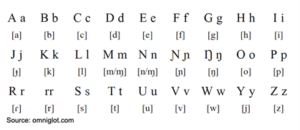By Megan Campbell
Niger has a wide variety of indigenous languages, which are usually majority languages that are natively spoken in a certain area. Hausa, spoken all over Niger, is the most widely spoken indigenous language. Zarma is the second leading language, and it is spoken primarily in the Southwest region of Niger, and in the capital city of Niamey.
Nigeriens speak English and French for business, education, and administration. But, indigenous languages are very important in local culture, for shopping, socializing, and developing relationships with Nigeriens. Zarma, particularly, is very important for communication in local markets and even in some professional circles.
The Zarma Language Has a Rich History
Zarma is part of the Songhai group of languages. The origin of this group can be traced back to the Songhai empire in the fifteenth century. The empire later fell in the sixteenth century, and the language group fragmented into two distinct branches: Northern and Southern. The Southern branch is concentrated around the Niger River and southeastern Niger.
Zarma speakers can understand some other Songhai languages, including Songhoyboro Ciine and Dendi. This is similar to how Spanish speakers can often understand Portuguese because the languages are so closely related, but they would not be able to understand French. Zarma speakers cannot, for example, understand Koyraboro Senni, which is spoken in Gao, Mali.
While Songhai languages can be found all over Western Africa, Zarma is spoken primarily in the southwestern part of Niger, and in cities such as Tillaberi, Dosso, Niamey, Tahoua, and Agadez. But, this language can also be found in other countries such as Mali, Benin, Nigeria, Ghana, and Burkina Faso. The Zarma people are also typically found in this region.
The Zarma ethnic group numbers approximately three million. This group dominates the public and private sectors in many locations and is known for craftsmanship and architecture. This group likewise accounts for the greatest majority of native Zarma speakers, but others in Zarma-dominated regions may learn the language due to its relevance to everyday communication.
Take a Closer Look at a Few Interesting Features of Zarma Language

The Zarma alphabet is based on the Latin script and features 25 letters. Interestingly, the letter “v” is not typically present in the language (though it can be found in some foreign words), and many native Zarma speakers cannot pronounce it. The Zarma alphabet also has a couple of additional nasal letters. Both N and M are nasal consonants, and you can feel the vibration of these sounds in your nose. For example, the funky-looking N in the above image is a nasal consonant, and it really just represents the “Ng” sound that you hear in words like “along,” or “hungry.”
Another interesting feature of the language is it is not gendered at all. You can refer to a “he” “she” or “they” with the same word. If you were talking about your friend John and his little sister, you could use the same pronoun to describe both of them. In this example, I could say, “I met John and his little sister yesterday,” and one could reply with “I love him!” In this case, the word “him” refers to both John and his little sister.
Verbs do not have tenses and are not conjugated, but certain aspects can be specified by markers before the word. A grammatical tense conveys information about the meaning and time of verbs. One aspect (called “perfectivity”) refers to the distinction between a completed action and an ongoing action. For example, the English sentence “I have finished eating” would be formatted as “I eat [marker] finish.” The marker refers to the action being completed.
Zarma is a subject-object-verb (SOV) language with postpositions. English is a subject-verb-object (SVO) language. The sentence “I drew dogs,” would become “I dogs drew” in Zarma. Additionally, suffixes are used in Zarma to denote what kind of article (like “a” or “the”) a noun should have. So, the English sentence “I gave the ball to her,” would look like “I ball-the gave her to.” And, the phrase “I love Zarma” is translated to “I Zarma love” in SVO form.
So, in conclusion, I Zarma love!
Sources:
https://en.wikipedia.org/wiki/Songhay_languages
https://en.wikipedia.org/wiki/Zarma_language#References
https://files.peacecorps.gov/multimedia/audio/languagelessons/niger/NE_Zarma_Language_Lessons.pdf
https://nalrc.indiana.edu/doc/brochures/zarma.pdf
https://www.britannica.com/topic/Zarma


